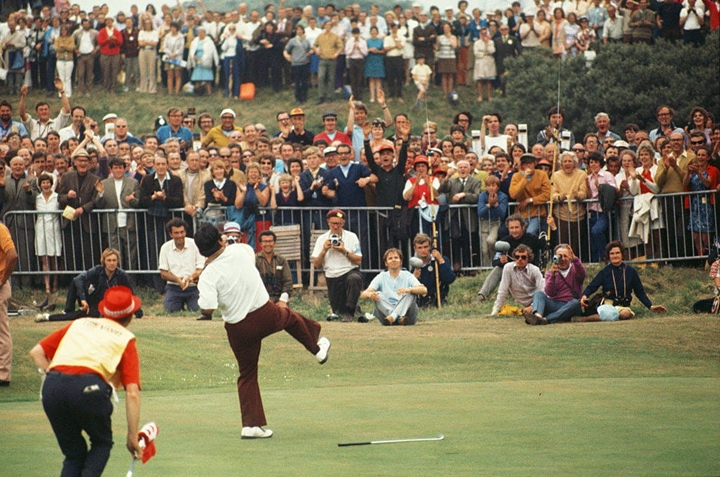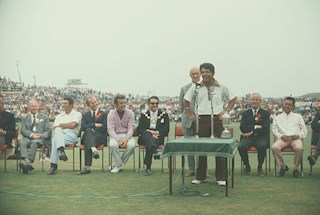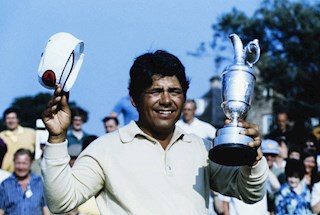Tales of The Open
Lee Trevino recalls rapid final act at Royal Birkdale

The final putt of The 100th Open, at Royal Birkdale in 1971, neatly summed up the sky-high confidence of the newly-crowned Champion Golfer of the Year, Lee Trevino.
Twelve months earlier, Trevino had been present on the final green at St Andrews when Doug Sanders famously missed a short putt that would have secured the Claret Jug.
Sanders, who would go on to be beaten by Jack Nicklaus in a play-off, took plenty of time over his chance at glory and backed off his stroke at the last second before eventually pushing a nervy effort past the right-hand side of the cup.
When Trevino faced a similar putt for victory at Birkdale, he was so quick to seize his chance that the winning moment was almost not captured on film.
Trevino could have been forgiven for falling victim to anxiety. Having been five clear of nearest rival Lu Liang-Huan with nine holes to play, he had seen his lead cut to a solitary stroke before Lu completed an unlikely par save at the last.
Yet as he explained in our Tales of The Open podcast in December 2020, Trevino did not hesitate when left with a three-footer to seal the win.
“At the time my confidence was so up with the putter that I wasn’t taking any time whatsoever,” said Trevino.
“I’d just won the U.S. Open and the Canadian Open, this was my third tournament (win) in a row, and I was putting extremely well.
“If you look at the film, the camera was following Mr Lu. Everybody was giving him a standing ovation. And I put my ball down, picked up the coin, and knocked the three-footer in the middle of the hole to win my third tournament in a row.”
Trevino’s caddie, Willie Aitchison, had earlier played a key role in keeping his player upbeat. A double-bogey at 17 had cut the lead of Trevino from three to one, but he remained in front as Lu missed an opportunity to make birdie at the same hole.
“I was upset at what I did, but also I’d been in this position before,” Trevino added.
“Willie Aitchison said to me: ‘Listen, don’t get upset, you’re still leading. If you’d lost your lead, I can see why you could get upset. But you didn’t lose your lead, you only lost two shots.’”
Trevino duly held his nerve to par the last, his no-nonsense approach to a potentially tense situation on the final green typifying the understandable self-belief of one of the most naturally gifted players golf has ever seen.

Having been introduced to the sport as a child when his family moved to a new home close to Glen Lakes Country Club in Dallas, Trevino quickly realised he was capable of extraordinary things.
“On the back of the caddie shack we had a little three-hole triangle golf course that we built ourselves out of the dirt. And we’d all get back there after we caddied,” he said.
“Caddie fees were 90 cents for 18 holes, and we’d finish and we’d go out there and play for dimes and nickels. And I knew right then that I could make more money by playing the game than I could carrying the bag.
“What I did is I started practicing and I got better and better and better and better, and I started beating everybody. And it got to the point where every place that I played and everyone that I played I could beat. That’s how I got started, I got started on that golf course. That was my introduction to the game.
“Now it was up to me, because I didn’t have anyone pushing me. It was up to me, in other words, to pursue it, to build a passion, do a lot of sacrificing and pursue this game, and luckily I hit on it. The good Lord gave me the talent and I hit on it, and I started practicing more and more and more.”
In explaining his natural aptitude for golf, Trevino refers to a major film from the 1990s that made actor Matt Damon into a household name.
“I don’t know if you’ve ever seen the movie Good Will Hunting,” said Trevino. “That movie was all about mathematics and the professor could put any problem on the board and he (Damon) could solve it.
“And I remember, he and the professor sitting in a chair once, and the professor looked over at him and he said: ‘I don’t know how you do that.’ And do you remember what Damon said? Damon said: ‘It comes easy to me.’ And that’s what this game did with me. It came easy to me.
“I can do anything you want with a golf ball. I just have to think about it. All I have to do is stand over a golf ball and say: ‘OK, I’m gonna hit this ball high this way or low this way, I’m gonna bend it this way.’ And my body reacts to it. I don’t know why, but I can do tricks with a golf ball. I always could.”

Trevino certainly made the most of his talent. He went on to defend his Open title at Muirfield in 1972, becoming only the fourth post-war player to win the Championship in successive years, and finished his career with six major victories to his name.
In addition, he was one of the most popular players of any era, who thrilled crowds around the world with his joviality and penchant for storytelling.
“I actually went to a person one time and asked them why people made such a big deal out of me, because I couldn’t understand it. And he said it’s because there’s millions and millions and millions of people that are working and they’re doing something they don’t like, and they look at you and you’re doing something not only that you love, but you’re damn good at it and you make a living doing it and they just want to be a part of it,” said Trevino.
“I can see that in people. And if I can make them happy and make their day a little bit better, it doesn’t take any of my time because I’m walking by anyway.
"How much effort does it take for you to look at a person and say, ‘how’re you doing today?’ and don’t even break stride. Or just put your hand out there and give that person a high five. I like people, I like being around them.”














